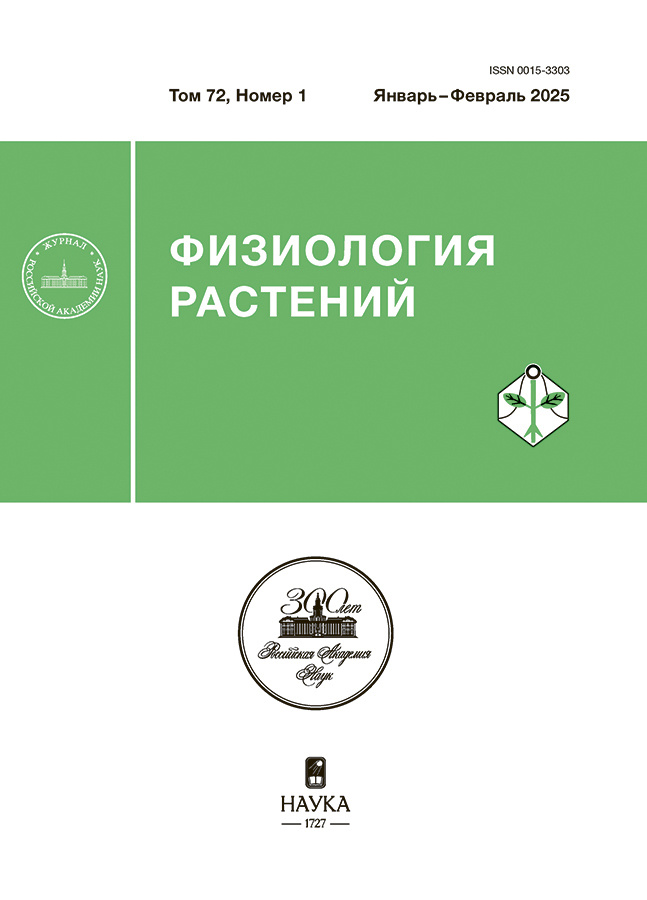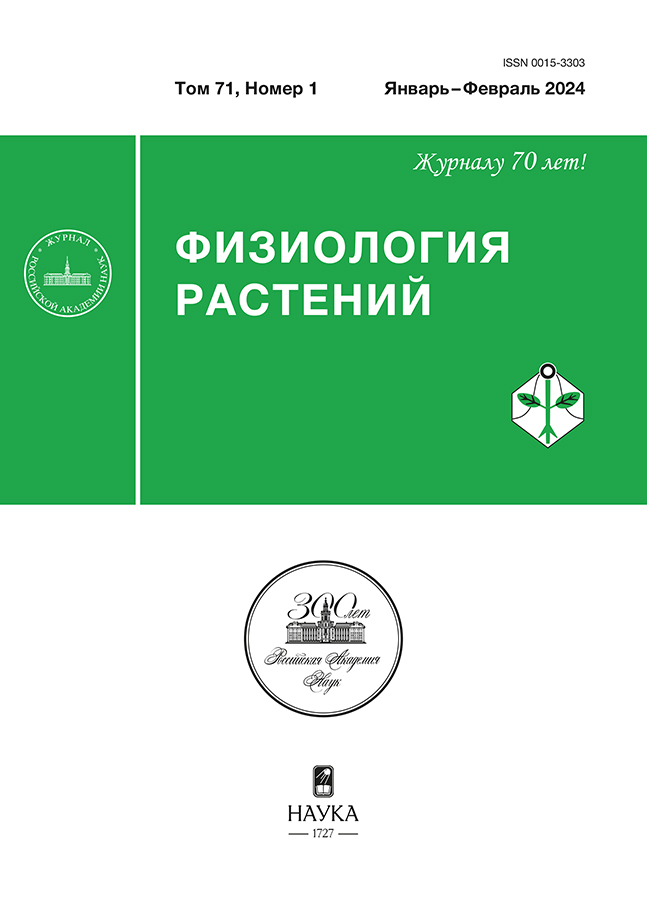Индуцированный бактериальным элиситором flg22 эндоцитоз в иммунной реакции клеток корней Arabidopsis thaliana
- Авторы: Халилова Л.А.1, Воронков А.С.1
-
Учреждения:
- Федеральное государственное бюджетное учреждение науки Институт физиологии растений им. К.А. Тимирязева Российской академии наук
- Выпуск: Том 71, № 1 (2024)
- Страницы: 3-13
- Раздел: ЭКСПЕРИМЕНТАЛЬНЫЕ СТАТЬИ
- URL: https://cardiosomatics.ru/0015-3303/article/view/648185
- DOI: https://doi.org/10.31857/S0015330324010011
- EDN: https://elibrary.ru/NWQHLL
- ID: 648185
Цитировать
Полный текст
Аннотация
Разнообразные молекулы патогенного происхождения, такие как бактериальный флагеллин (flg22), распознаются растениями через рецепторы плазматической мембраны и индуцируют как местные, так и системные иммунные реакции. При этом везикулярный транспорт является ключевым в обеспечении быстрого и точного реагирования. При взаимодействии с патогенами, локализованными на поверхности клеток, иммунные рецепторы подвергаются эндоцитозу по общему эндосомальному пути. Какой из везикулярных путей патогены используют для проникновения в ткани и какое значение имеет в этом процессе flot1 остается не до конца изученным. Данное исследование посвящено влиянию биотических факторов стресса на иммунную реакцию растений Arabidopsis thaliana дикого типа и его нокаут-мутанта Atflot1ko. Изучены процессы эндоцитоза под действием разных агентов: 1-нафталинлуксусной кислоты и метил-ß-циклодекстрина. С помощью трансмиссионной электронной микроскопии выявлены различия в ответных реакциях клеток на стресс, индуцированный flg22. Показано, что биотический стресс у нокаут-мутантов активирует секреторный путь (экзоцитоз), необходимый для защиты клеток от действиях патогена на поверхности клетки, тогда как у растений дикого типа активируется эндоцитоз, направленный на перемещение патогена в вакуоль. Полученные данные показали, что обработка мутантов Atflot1ko бактериальным пептидом сохраняет активность работы комплекса Гольджи и способность этой структуры формировать ранние эндосомы, принимающие непосредственное участие в транспорте защитных белков к месту проникновения патогена.
Полный текст
Об авторах
Л. А. Халилова
Федеральное государственное бюджетное учреждение науки Институт физиологии растений им. К.А. Тимирязева Российской академии наук
Автор, ответственный за переписку.
Email: lhalilova@mail.ru
Россия, Москва
А. С. Воронков
Федеральное государственное бюджетное учреждение науки Институт физиологии растений им. К.А. Тимирязева Российской академии наук
Email: lhalilova@mail.ru
Россия, Москва
Список литературы
- Mahalingam R. Consideration of сombined stress: a crucial paradigm for improving multiple stress tolerance in plants // Combined Stresses in Plants / Ed. R. Mahalingam. Springer Intern. Publ. Switzerland. 2015. P. 1. https://doi.org/10.1007/978-3-319-07899-1_1
- Jones J.D., Dangl J.L. The plant immune system // Nature. 2006. V. 444. P. 323.
- Inada N., Ueda T. Membrane trafficking pathways and their roles in plant-microbe interactions // Plant Cell Physiol. 2014. V. 55. P. 672. https://doi.org/10.1093/pcp/pcu046
- Ortiz-Morea F.A., Savatin D.V., Dejonghe W., Kumar R., Luo Y., Adamowski M., Van den Begin J., Dressano K., Pereira de Oliveira G., Zhao X., Lu Q., Madder A., Friml J., Scherer de Moura D., Russinova E. Danger-associated peptide signaling in Arabidopsis requires clathrin // Proc. Natl. Acad. Sci. USA. 2016. V. 113. P. 11028. https://doi.org/10.1073/pnas.1605588113
- Geldner N., Robatzek S. Plant receptors go endosomal: A moving view on signal transduction // Plant Physiol. 2008. V. 147. P. 1565. https://doi.org/10.1104/pp.108.120287
- Freidit Frey N., Robatzek S. Trafficking vesicles: pro or contra pathogens? // Curr. Opin. Plant Biol. 2009. V. 12. P. 437. https://doi.org/10.1016/j.pbi.2009.06.002
- Sorkin A., von Zastrow M. Endocytosis and signalling: Intertwining molecular networks // Nat. Rev. Mol. Cell Biol. 2009. V. 10. P. 609. https://doi.org/10.1038/nrm2748
- Li R., Liu P., Wan Y., Chen T., Wang Q., Mettbach U., Baluska F., Samaj J, Fang X., Lucas W.J., Lin J. A membrane microdomain-associated protein, Arabidopsis Flot1, is involved in a clathrin-independent endocytic pathway and is required for seedling development // Plant Cell. 2012. V. 24. P. 2105. https://doi.org/10.1105/tpc.112.095695
- Khalilova L.A., Sergienko O.V., Orlova Y.V., Myasoedov N.A., Karpichev I.V., Balnokin Y.V. Arabidopsis thaliana mutant with t-DNA insertion in the Flot1 (At5g25250) gene promotor possesses increased resistance to NaCl // Russ. J. Plant Physiol. 2020. V. 67. P. 275. https://doi.org/10.1134/S1021443720020077
- Khalilova L.A., Voronkov A.S. The membrane nanodomain Flot1 protein participates in formation of the early endosomes in the root cells of Arabidopsis thaliana // Russ. J. Plant Physiol. 2023. V. 70. P. 74. https://doi.org/10.1134/S1021443723600307
- Boller T., Felix G. A renaissance of elicitors: Perception of microbe-associated molecular patterns and danger signals by pattern-recognition receptors // Ann. Rev. Plant Biol. 2009. V. 60. P. 379. https://doi.org/10.1146/annurev.arplant.57.032905.105346
- Böhm H., Albert I., Fan L., Reinhard A., Nürnberger T. Immune receptor complexes at the plant cell surface // Curr. Opin. Plant Biol. 2014. V. 20. P. 47. https://doi.org/10.1016/j.pbi.2014.04.007
- Dodds P.N., Rathjen J.P. Plant immunity: towards an integrated view of plant-pathogen interactions // Nat. Rev. Genet. 2010. V. 11. P. 539. https://doi.org/10.1038/nrg2812
- Monaghan J., Zipfel C. Plant pattern recognition receptor complexes at the plasma membrane // Curr. Opin. Plant Biol. 2012. V. 15. P. 349. https://doi.org/10.1016/j.pbi.2012.05.006
- Kunze G., Zipfel C., Robatzek S., Niehaus K., Boller T., Felix G. The N terminus of bacterial elongation factor Tu elicits innate immunity in Arabidopsis plants // Plant Cell. 2004. V. 16. P. 3496. https://doi.org/10.1105/tpc.104.026765
- Robatzek S., Chinchilla D., Boller T. Ligand-induced endocytosis of the pattern recognition receptor FLS2 in Arabidopsis // Gene Dev. 2006. V. 20. P. 537.https://doi.org/10.1101/gad.366506
- Radutoiu S., Madsen L.H., Madsen E.B., Jurkiewicz A., Fukai E., Quistgaard E.M.H., Albrektsen A.S., James E.K., Thirup S., Stougaard J. LysM domains mediate lipochitin-oligosaccharide recognition and Nfr genes extend the symbiotic host range // EMBO J. 2007. V. 26. P. 3923. https://doi.org/10.1038/sj.emboj.7601826
- Gómez-Gómez L., Boller T. FLS2: an LRR receptor-like kinase involved in the perception of the bacterial elicitor flagellin in Arabidopsis // Mol. Cell. 2000. V. 5. P. 1003. https://doi.org/10.1016/s1097-2765(00)80265-8
- Chinchilla D., Zipfel C., Robatzek S., Kemmerling B., Nürnberger T., Jones J.D., Felix G., Boller T. A flagellin-induced complex of the receptor FLS2 and BAK1 initiates plant defence // Nature. 2007. V. 448. P. 497. https://doi.org/10.1038/nature05999
- Sun Y., Li L., Macho A.P., Han Z., Hu Z., Zipfel C., Zhou J.M., Chai J. Structural basis for flg22-induced activation of the Arabidopsis FLS2-BAK1 immune complex // Sci. 2013. V. 342. P. 624. https://doi.org/10.1126/science.1243825
- Zipfel C., Robatzek S., Navarro L., Oakeley E.J., Jones J.D., Felix G., Boller T. Bacterial disease resistance in Arabidopsis through flagellin perception // Nature. 2004. V. 428. P. 764. https://doi.org/10.1038/nature02485
- Salomon S., Robatzek S. Induced endocytosis of the receptor kinase FLS2 // Plant Signal. Behav. 2006. V. 1. P. 293. https://doi.org/10.4161/psb.1.6.3594
- Russinova E., Borst J.W., Kwaaitaal M., Caño-Delgado A., Yin Y., Chory J., de Vries S.C. Heterodimerization and endocytosis of Arabidopsis brassinosteroid receptors BRI1 and AtSERK3 (BAK1) // Plant Cell. 2004. V. 16. P. 3216. https://doi.org/10.1105/tpc.104.025387
- Beck M., Zhou J., Faulkner C., MacLean D., Robatzek S. Spatio-temporal cellular dynamics of the Arabidopsis flagellin receptor reveal activation status-dependent endosomal sorting // Plant Cell. 2012. V. 24. P. 4205. https://doi.org/10.1105/tpc.112.100263
- Lu D., Lin W., Gao X., Wu S., Cheng C., Avila J., Heese A., Devarenne T.P., He P., Shan L. Direct ubiquitination of pattern recognition receptor FLS2 attenuates plant innate immunity // Sci. 2011. V. 332. P. 1439. https://doi.org/10.1126/science.1204903
- Smith J.M., Salamango D.J., Leslie M.E., Collins C.A., Heese A. Sensitivity to Flg22 is modulated by ligand-induced degradation and de novo synthesis of the endogenous flagellin-receptor FLAGELLIN SENSING2 // Plant Physiol. 2014. V. 164. P. 440. https://doi.org/10.1104/стр.113.229179
- Scheuring D., Künzl F., Viotti C., Yan M.S., Jiang L., Schellmann S., Robinson D.G., Pimpl P. Ubiquitin initiates sorting of Golgi and plasma membrane proteins into the vacuolar degradation pathway // BMC Plant Biol. 2012. V. 12. P. 164. https://doi.org/10.1186/1471-2229-12-164
- Ben Khaled S., Postma J., Robatzek S. A moving view: subcellular trafficking processes in pattern recognition receptor-triggered plant immunity // Ann. Rev. Phytopathol. 2015. V. 53. P. 379. https://doi.org/10.1146/annurev-phyto-080614-120347
- Mishina T.E, Zeier J. Pathogen-associated molecular pattern recognition rather than development of tissue necrosis contributes to bacterial induction of systemic acquired resistance in Arabidopsis // Plant J. 2007. V. 50. P. 500. https://doi.org/10.1111/j.1365-313X.2007.03067.x
- Khalilova L.A., Lobreva O.V., Nedelyaeva O.I., Karpichev I.V., Balnokin Y.V. Involvement of the membrane nanodomain protein, AtFlot1, in vesicular transport of plasma membrane H+-ATPase in Arabidopsis thaliana under salt stress // Int. J. Mol. Sci. 2023. V. 24. P. 1251. http://doi.org/10.3390/ijms24021251
- Narasimhan M., Gallei M., Tan S., Johnson A., Verstraeten I., Li L., Rodriguez L., Han H., Himschoot E., Wang R., Vanneste S., Sánchez-Simarro J., Aniento F., Adamowski M., Friml J. Systematic analysis of specific and nonspecific auxin effects on endocytosis and trafficking // Plant Physiol. 2021. V. 186. P. 1122. https://doi.org/10.1093/plphys/kiab134
- Keinath N.F., Kierszniowska S., Lorek J., Bourdais G., Kessler S.A., Shimosato-Asano H., Grossniklaus U., Schulze W.X., Robatzek S., Panstruga R. PAMP (pathogen-associated molecular pattern)-induced changes in plasma membrane compartmentalization reveal novel components of plant immunity // J. Biol. Chem. 2010. V. 285. P. 39140.https://doi.org/10.1074/jbc.M110.160531
- Malinsky J., Opekarova M., Grossmann G., Tanner W. Membrane microdomains, rafts, and detergent-resistant membranes in plants and fungi // Annu. Rev. Plant Biol. 2013. V. 64. P. 501. https://doi.org/10.1146/annurev-arplant-050312-120103
- Yu M., Liu H., Dong Z., Xiao J., Su B., Fan L., Komis G., Samaj J., Lin J., Li R. The dynamics and endocytosis of Flot1 protein in response to flg22 in Arabidopsis // J. Plant Physiol. 2017. V. 215. P. 73. https://doi.org/10.1016/j.jplph.2017.05.010
- Cui Y., Li X., Yu M., Li R., Fan L., Zhu Y., Lin J. Sterols regulate endocytic pathways during flg22-induced defense responses in Arabidopsis // Development. 2018. V. 145. dev165688. https://doi.org/10.1242/dev.165688
- Yeh Y.H., Chang Y.H., Huang P.Y., Huang J.B., Zimmerli L. Enhanced Arabidopsis pattern-triggered immunity by overexpression of cysteinerich receptor-like kinases // Front. Plant Sci. 2015. V. 6. P. 322. https://doi.org/10.3389/fpls.2015.00322
- Koh S., Andre A., Edwards H., Ehrhardt D., Somerville S. Arabidopsis thaliana subcellular responses to compatible Erysiphe cichoracearum infections // Plant J. 2005. V. 44. P. 516. https://doi.org/10.1111/j.1365-313X.2005.02545.x
- Assaad F.F., Qiu J.L., Youngs H., Ehrhardt D., Zimmerli L., Kalde M., Wanner G., Peck S.C., Edwards H., Ramonell K. Somerville C.R., Thordal-Christensen H. The PEN1 syntaxin defines a novel cellular compartment upon fungal attack and is required for the timely assembly of papillae // Mol. Biol. Cell. 2004. V. 15. P. 5118.https://doi.org/10.1091/mbc.e04-02-0140
- Choi S.W., Tamaki T., Ebine K., Uemura T., Ueda T., Nakano A. RABA members act in distinct steps of subcellular trafficking of the FLAGELLIN SENSING2 receptor // Plant Cell. 2013. V. 25. P. 1174. https://doi.org/10.1105/tpc.112.108803
- Mbengue M., Bourdais G., Gervasi F., Beck M., Zhou J., Spallek T., Bartels S., Boller T., Ueda T., Kuhn H., Robatzek S. Clathrin-dependent endocytosis is required for immunity mediated by pattern recognition receptor kinases // Proc. Natl. Acad. Sci. USA. 2016. V. 113. P. 11034. https://doi.org/10.1073/pnas.1606004113
Дополнительные файлы















